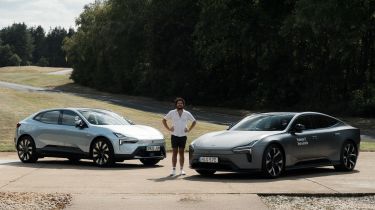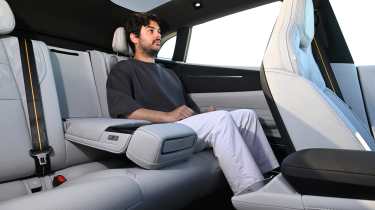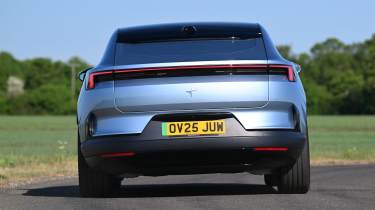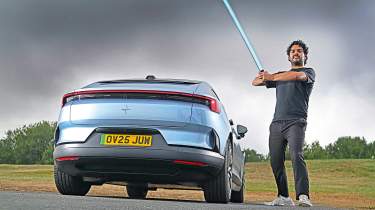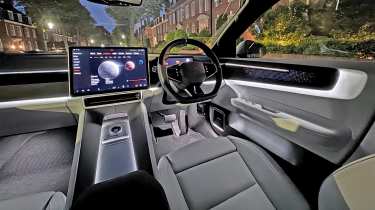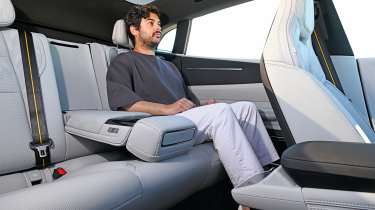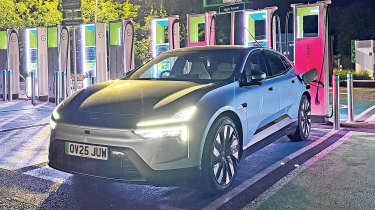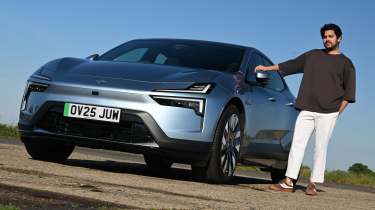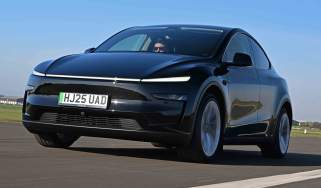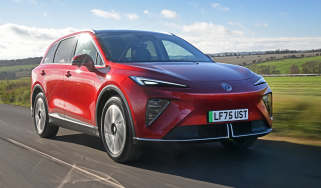Long-term test: Polestar 4 Dual Motor
Final report: sleek Swedish SUV leaves our fleet having impressed our man with its huge breadth of talent

Verdict
Over almost 4,500 miles and six months, I’ve loved our Polestar 4. This behemoth of a car was loud and quiet: very fast yet effortlessly refined. It wormed its way into my affections like few long-term test cars have over the course of nearly 10 years in this job. It’s not perfect, but every time I returned to it, I was always very happy to get behind the wheel.
- Mileage: 4,622 miles
- Efficiency: 3.6mi/kWh
The Polestar 4 joined our test fleet with a substantial weight on its shoulders. Its manufacturer is going through some major challenges and a tough period financially. If it wants to survive, its cars need to do the talking. And if you’ll forgive me cutting to the chase, the good news is that, despite my initial reservations about its shape and sheer size, the Polestar 4 has alleviated any fears about its maker’s long-term health, and then some.
Over the course of the past six months, I’ve relished every moment with the car, because it offers a collection of elements that perfectly complement my busy and fast-paced weekly schedule.
One of the real highlights of this car is its cabin. I never grew tired of the design, displays or interfaces, and aside from the ‘virtual key’ being convinced I should be assigned the ‘Guest’ profile, it was pretty much flawless from the off.
Once the infotainment was set up to suit my preferences, with some clever shortcuts put on the main display and my log-ins sorted on the Google interfaces, everything just worked. It’s also worth mentioning the stereo and interior lighting, because both were a hit with me and my passengers alike. The set-up did refuse me access to the climate controls once, but this happened after I attempted to pre-condition the cabin from the app, so that could have confused the system.
The rear seats also never failed to elicit a gasp as passengers opened the door. Not only is there loads of space, but it also feels especially light and airy, thanks to the huge glass roof and our car’s eye-wateringly expensive ice-blue Nappa leather seats.
This area of the car, just like the front, felt luxurious and opulent without its design following the herd of rival cars, whose manufacturers seem able only to come up with some sort of luxury car cliché. There’s no fake leather, excessive chrome or glossy black surfaces in the Polestar; instead, there are woven fabrics, rubberised non-coated plastics and real metal. Sitting in here, you feel as if you’re in the lobby of a modern technology company backed by a billion-pound investment, not the drawing room in your great uncle’s Victorian semi.
We would add one caveat – which the Polestar team is already aware of – that the centre console’s aluminium cover doesn’t appear to be quite as hardy as an iPhone. A heavy application of throttle would often see my phone thrown out from the wireless charger and bashing the metal. The car may be showing some scars, but I’m happy to report that the phone is totally fine.
This problem was only emphasised because our Dual Motor variant is fast. Really fast. The full performance can take some time to access because of the dull throttle response, but the electric powertrain has the character of a big, brawny diesel engine, rather than a highly strung Tesla. It’s also efficient, averaging 3.6mi/kWh. This is an incredible figure – equal to what you get in EVs that are substantially smaller and slower.
True, the car doesn’t handle that sharply, but taking into account its presentation and luxurious appointments, this is no bad thing. Models like the Polestar 4 might be marketed as ‘dynamic’ or ‘sporty’, but in reality this car has no more need to drive with a sense of dynamism than a Volvo S90 saloon – and few buyers ever marked that down for being a pudding around corners.
I loved the 4, but I realise it’s not a cover-all-the-bases winner. Pet owners won’t find the enclosed boot of much use, for example, and the car’s sheer width can make it tricky to thread through small villages, city streets, and even relatively narrow dual-carriageways.
A little more room under the bonnet to store the charge cables would be better than the awkward cubby under the boot floor, too. Plus the front seats are a bit flat and hard – although the massage function made up for this.
As a result, I feel this isn’t a car that will necessarily suit a wide range of customers. However, ones who are looking for a car that’s effortless, comfortable and connected, and feels like a product of 2025, rather than 1995, will find plenty to like here. Don’t listen to the sceptics – I reckon Polestar’s here to stay.
Polestar 4 Dual Motor: second fleetwatch
Geely ties reveal some common ground with Lotus, but our Polestar 4 lacks the Hethel handling finesse
We recently spent some time in the Lotus Emira, which despite being about as far away as possible from our Polestar 4 in terms of its form, highlighted some interesting common ground. You see, both brands are owned by the same parent company, Geely, which means there’s actually more than a little technical crossover between the two marques. Unfortunately, not much of the Emira’s ride and handling expertise has rubbed off on the 4, but as we’ll come to in the next report, there’s a reason for that.
Polestar 4 Dual Motor: second report
The force is with us when driving our space-age EV
- Mileage: 2,789
- Efficiency: 3.5mi/kWh
I’m going to reveal something I might well regret, but here goes: I love Star Wars. Not sci-fi in general, but Star Wars specifically. And when I found out that I’d be the lucky custodian of a Polestar 4, there was one big reason I was really looking forward to it. It sort of looks like the Millennium Falcon… a bit. Well, maybe if you squint.
Anyway, there’s something about how the high rear end, the lack of rear window and an almost semi-circular profile combine to look both contemporary and retro at the same time.
However, I don’t think our car looks particularly futuristic. Its light metallic blue paint and black lower bumpers don’t sit all that comfortably with the ultramodern vibe – but in my mind it still doesn’t erode this association; the Polestarship still makes me smile every time I walk up to it.
The sci-fi aesthetic doesn’t just relate to its exterior, but also the interior. I love the cabin, which is simple, yet features lots of clever, subtle design features that lift it above most rivals’. It’s not cluttered or awkward, as you’ll see on brands such as Audi or Mercedes, but nor is it stark like a Tesla, either.
There’s another nod to my inner sci-fi nerd in the ambient lighting. Rather than choosing between colours, each of the nine options is inspired by a planet in our solar system, or the sun, bringing up a screen with a graphic that also gives you key information about it.
Aside from being a bit of a quirk, my inner eight-year-old thinks this looks like a display screen from the Death Star, assessing other planets to see how much laser power is needed for (evil voice) “TOTAL ANNIHILATION”. My personal preference is the soft-mid white ambience of Mercury, but I’m sometimes tempted by the sun’s warmer hue.
The really slick bit, though, is how the lighting is integrated into the cabin – it’s done so cleverly on the dash, console and doors that every time I drive at night I still get a little tickle.
Life isn’t quite perfect inside our Pole-Death Star, though. As is often the case with modern, software-heavy cars, there have been a few irritations. Things such as the way the Digital Key on my phone often kicks the car into the ‘Guest’ profile when I get in. It’s obvious the Polestar is having a moment when you open the door, as the steering wheel and seats begin their electronic dance to a completely random position, and the interior lighting reverts to the blue ‘Earth’ setting.
Annoyingly you can’t change the driver profiles on the move, either, so you have to sit there, wait for the Guest setting to load and then swap back. We’ve even deleted and redownloaded the key a few times, but it still reverts to the Guest setting. I hope there’s an easy fix when the car goes for its first service.
Other irritations are a screen that can be switched to a crisp and clean Google Maps view, but my preference for ‘night mode’ only goes as far as that display. The main view on the screen retains its daytime view – I wonder if this is another thing that’ll be fixed by an update. Plus, the air vents never seem to blow where I want. A couple of tabs would be an easy solution for a problem that shouldn’t be there.
Overall, I’m still loving its serene cruising ability and high performance – life aboard the Polestarship Enterprise is good. Sorry, that’s from Star Trek, but I ran out of Star Wars puns…
Polestar 4 Dual Motor: first fleetwatch
We cover over 300 miles without breaking a sweat
Some long journeys have given us the chance to evaluate our Polestar 4’s ability on a motorway. Refinement impressed us and the efficiency has been very good, although short of its claimed 367-mile WLTP range. A trip north from London saw us arrive for a top-up with 25 per cent charge remaining after doing 235 miles, meaning we would have seen around 310 miles from a single charge.
Polestar 4 Dual Motor: first report
Swedish firm’s latest offering looks great on paper, but who is it aimed at?
- Mileage: 1,385
- Efficiency: 3.5mi/kWh
Is it just me, or did last year’s news of Polestar’s sticky financial results feel a little at odds with the increasing number of the company’s cars you see on UK roads?
It seems that for every Tesla Model 3, there’s a Polestar 2 just around the corner. In fact, it turns out the UK is the Swedish brand’s biggest market, which means the all-new Polestar 4 we’ve got our hands on for the next six months is probably more important than you might have thought.
We’ll start with where it sits in the company’s range, because the 4 is not a replacement for the smaller Polestar 2; instead, the new car sits above its range-mate. It’s priced from a round £60,000 for the entry-level single-motor car, putting it just above a top-spec Polestar 2 Dual Motor Performance Pack, and the line-up follows a similar format, offering different powertrains with various option packages, but no distinct trim levels.
The confusing Polestar naming convention dictates an order of a chronological nature for its models, rather than size. As such, the ‘3’ name has already been taken up by the larger and more traditional SUV that rivals the BMW iX, and is subsequently more expensive than both 2 and 4. Got it? No? It sort of makes sense, but you know what they say: if you need to explain it…
Anyway, our Polestar 4 is a Dual Motor variant with a basic list price of £67,000, but it comes with a few options that bump up the cost and specification. These include £1,000 worth of Electron silver-blue paint and a chunky £3,300 upgrade to Nappa leather seats in Zinc with a massage function. The £1,800 Pro pack rounds things off by adding a larger set of 21-inch wheels, gold dustcaps and a gold stripe to the seatbelts. All in, we’re at £73,100 – not an inconsiderable amount of money, but as we’ll discover, this is also an awful lot of car.
There’s not much missing from our specification, but the Performance Package with its 22-inch wheels, bigger Brembo brakes and unique chassis tuning is a notable exception.
On first impression, I like the silver-blue monochromatic palette inside and out. Parked on my crowded London street, the 4 looks huge, even next to the gargantuan BMW M5 Touring that I also happened to have on test when the Polestar arrived. The Swedish car’s tall stature, sloping roofline and broad shoulders mean it’s a cross between an SUV, a coupé and traditional saloon.
At 4.8m long, it’s only slightly longer than most mid-size premium SUVs, but is nearly 4cm wider than a full-size Audi Q7. With this large footprint comes a very large cabin, yet it’s unlike most European cars in the way it apportions that space. The boot is relatively large – bigger than I’ll generally need, at 526 litres – but the bulk of the interior space is given over to the rear seats. This is very important in the car’s core Chinese market, and while the second row of our car won’t be used on a daily basis, when I do have multiple passengers, they’re adults rather than sticky-fingered kids. So the space will be handy.
What we’re left with, then, is a large, spacious and very luxurious crossover-type EV that has loads of kit and a very impressive 367-mile WLTP range, thanks to its 100kWh battery pack. There’s also the rather significant 536bhp, a colossal 686Nm of torque and a 0-62mph time of 3.7 seconds. While I’m under no impression that this is a performance car,
I have already enjoyed the sheer ease with which it can deploy its vast reserves. It seems Polestar has ambitions to do it all with the 4.
I’ve managed to get this far without talking about the fact the car doesn’t have a rear window, but I am going to mention it here purely as a symbol. And that’s because the 4, more than any of Polestar’s other models, seems to be one that has no interest in looking back. We’ll be finding out if that’s a good thing over the next six months.
| Rating: | 4.0 stars |
| Model: | Polestar 4 Dual Motor |
| On fleet since: | April 2025 |
| Price new: | £67,000 |
| Powertrain: | 2x e-motor, 100kWh battery |
| Power/torque: | 536bhp/686Nm |
| CO2/BiK: | 0g/km/3% |
| Options: | Metallic paint (£1,000), Pro Pack (£1,800), Nappa massaging seats (£3,300) |
| Insurance*: | Group 48 Quote: £1,407 |
| Mileage: | 4,622 miles |
| Efficiency: | 3.6 miles/kWh |
| Any problems? | Issues with digital key |
*Insurance quote from AA (0800 107 0680) for a 42-year-old in Banbury, Oxon, with three points.

